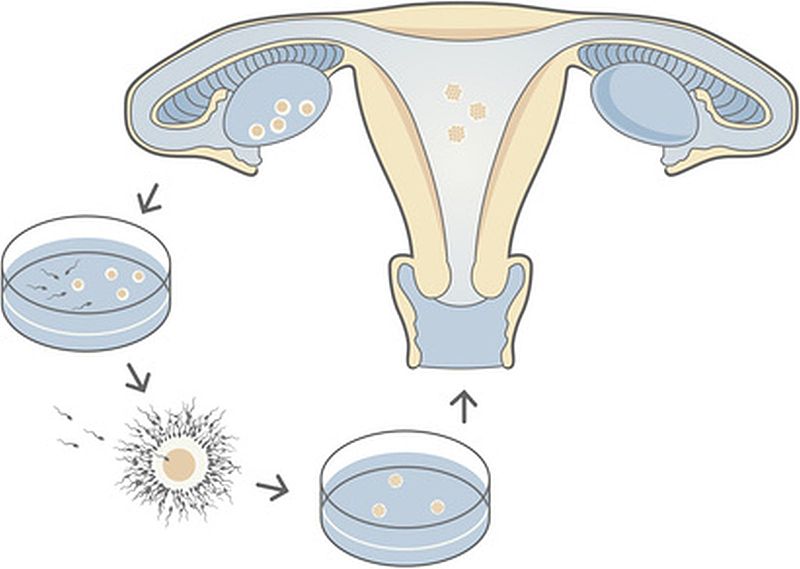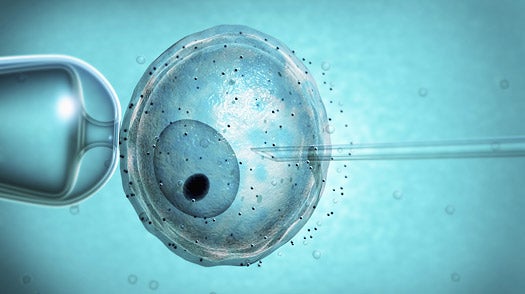
Assisted reproductive technology (ART), is a class of medical treatments and procedures used to help people dealing with various forms of infertility conceive a child.1 There are various forms, and as every person’s situation is different, the specifics are best to be discussed with a medical provider and/or fertility specialist. If you would like to know more about the biology of infertility before reading this article, check out our articles on Male Infertility and Female Infertility.
In Vitro Fertilization (IVF)
The most common form of ART is known as in vitro fertilization, or IVF.2 In this procedure, eggs and sperm are collected and the process of fertilization and embryo formation occurs outside of the body, in a laboratory. A medical professional can then insert the embryo into the uterus, where it can then attach to the uterine lining and result in pregnancy.1
There are a few basic steps in the process of IVF: superovulation, egg retrieval, fertilization, and embryo transfer.1

Superovulation: Superovulation, which can also be referred to as ovarian stimulation, ovulation induction, and stimulation of egg maturation, is the first step of IVF. The person giving their eggs receives medication via injection for 8 to 14 days. This medication helps the ovaries produce a greater amount of mature eggs at one time. During the period of medication injection, a medical professional observes how the eggs are developing through the use of ultrasound technology and blood tests. Once they determine that the eggs are mature, ovulation is stimulated by a hCG hormone injection. 34 to 36 hours after ovulation is initiated by the injection, a medical professional retrieves the eggs.1
Egg Retrieval: At this point in the treatment, a physician is able to remove the eggs that were previously stimulated by the hCG hormone. The actual egg retrieval begins with the insertion of an ultrasound probe into the vagina. This probe allows the physician to see the ovaries and their follicles, which is where the eggs are. Then a needle is guided through the vagina to the ovaries, using the ultrasound probe. The needle has a suction capability which allows it to collect the eggs from the ovaries. This process is an outpatient procedure and typically lasts about 30 minutes. A mild painkiller is sometimes used post-procedure to ease any discomfort the patient may have.1
Fertilization: Once the eggs have been collected, they can be joined with sperm for fertilization. If the sperm in the semen sample are healthy, they are centrifuged in order to separate the sperm from the rest of the seminal fluid. Once the sperm are isolated, they are placed in a petri dish with an egg, where they are left in an incubator to fertilize. If they are not able to fertilize on their own, a process called intracytoplasmic sperm injection (ICSI) can be used to facilitate fertilization.1 In ICSI, a single sperm can be injected directly into the center of the egg with a needle.3 Both methods of fertilization have about the same rates of pregnancy.1

Embryo Implant: Once the fertilized embryos are formed, they are implanted in the uterus within six days of the retrieval of the unfertilized eggs. The process of transferring the embryo into the uterus is facilitated by a long, thin tube. Within 6 to 10 days of the original egg retrieval, the embryo should attach itself to the uterine lining.1
To maximize the embryo’s ability to implant, the uterine lining can be prepared with estrogen and progesterone medications, or by timing the implantation with the woman’s ovulation cycle. If a female wants to time the implantation with her ovulation, or if she decides to save it for a later date, she has the option to preserve her eggs or fertilized embryos by freezing them. The eggs can be thawed at a later date and used for implantation just the same.1
Post Implantation: Once the embryo is implanted in the uterus, the pregnancy is closely monitored by a physician to maintain the health and safety of the mother and the child. Frequent and open communication with a physician or fertility expert can be extremely beneficial and ensure that any pregnancy complications are avoided.
Intrauterine Insemination (IUI)
Intrauterine insemination, or IUI, is a procedure in which sperm is inserted into the uterus with a long, thin tube. In some cases, this treatment is combined with medication that stimulates ovulation in order to maximize the chance of pregnancy. This is an option for those who cannot get pregnant for a variety of reasons, including scarring or defects of the cervix in the female, or any sort of sperm or erectile issues in the male.1
Sperm, Egg, and Embryo Donation
Sperm Donation: If the male cannot produce sperm, if the mother does not have a partner and wants to have a child on her own, or if a lesbian couple wants to have a child, donated sperm can be used for IUI or IVF.1 Donated sperm is collected and held by sperm banks, which people can visit when looking for a donor. These facilities have a profile on each donor, allowing the person looking for a donor to choose one that fits their preferences. Donors are required to share family and personal medical histories, and are given a full medical evaluation that includes STI screenings. Usually, a donor gives up all rights to his sperm upon donation, and therefore has no right to know the identity of the mother or child. In some cases, but not all, once the child reaches the age of 18, they may have the ability to find out the identity of the sperm donor.4
Egg Donation: If the female is unable to produce healthy eggs that are fit for fertilization, there is the option of egg donation. Another female egg donor can undergo the superovulation and egg retrieval procedures outlined earlier, and one of those eggs can be fertilized by the child’s father’s sperm, and then implanted into the mother’s uterus.1
Embryo Donation: If a couple trying to conceive is unable to produce a viable embryo, they can look at embryo donation, also known as embryo adoption. This process allows the recipient mother to be pregnant with and give birth to their adopted baby. An embryo donation agency collects and stores frozen embryos from couples who have undergone IVF and have chosen to donate their “leftover” embryos, and these can then be donated to women or couples who are having trouble producing an embryo.1
Preparing for ART
Before beginning any kind of fertility treatment, there are certain things that can be done to prepare the body for a healthy pregnancy. Caffeine should be limited or eliminated, and cigarettes and alcohol should be completely eliminated. Having a regular exercise regimen can be very beneficial by controlling weight and providing stress relief, as well as healthy eating habits that incorporate smaller portions of foods with high nutritional value. Adding a folic acid supplement is also recommended. In addition, any chronic conditions such as high blood pressure, arthritis, diabetes, etc. should be kept under control with the help of a physician.5

Prior to starting treatment, it is important to visit a doctor and discuss any medications that are taken regularly. Certain medications can affect the outcome of fertility treatment or can cause birth defects, so having a physician look over any prescription, and over-the-counter medications, as well as and herbal supplements is an important step.5
For more information on having a healthy pregnancy, read our articles on Tips for Healthy Pregnancy and Prenatal Vitamins.
Surrogate or Gestational Carrier

In some cases, the female is not able to physically carry a child or a pregnancy can pose a major threat to her health. Nowadays, there are ways to have a child without physically carrying it. This kind of technology can also be used to make it possible for LGBTQ+ couples to have biological children of their own.
Surrogates: If a woman is unable to produce healthy eggs, is unable to have her eggs fertilized, or if a LGBTQ+ couple wants to have biological children, they can use a surrogate. A surrogate is a female that forms an agreement with a couple to carry their baby to term for them. She is inseminated with the sperm of the future father of the child, so the child will be the biological offspring of the surrogate and the male partner of the couple.1
Gestational Carrier: If a female is able to produce healthy eggs that can be fertilized, but cannot carry a child to term, she may look in to using a gestational carrier. This is a female who is impregnated with an embryo and carries it to term. This embryo could be the product of the couple, or egg and/or sperm donors. In this case, the carrier of the child would have no biological relationship to the child1.
Surrogacy Qualifications: There are a handful of qualifications a female should meet if she is to be a surrogate. Good candidates for surrogacy should:
- Have good mental/physical health
- Be less than 43 years old (concrete cut-offs depend on the agency)
- Have a stable living situation (home, job, etc.)
- Not abuse alcohol or smoke cigarettes
- Have carried at least one child to term and given birth
- Not had any pregnancy complications in the past
Any other qualities or characteristics can be decided on by the couple, as it is ultimately their choice of who carries their child.6
Finding and Choosing a Surrogate: Picking a surrogate can be a very long and arduous process all on its own. Many couples decide to use a family member or close friend, because it can greatly reduce the cost and might bring a certain level of comfort to the experience. If that is not an option, couples can look at agencies that work specifically to pair up couples with a surrogate. When choosing an agency, it is important to do thorough research and make sure that an agency is credible, reliable, and fair. Looking into the agency’s history, fees, screening processes of surrogates, as well as former client testimonies can provide valuable information. If the intended parents want to find a surrogate by their own means, it is recommended that they do it at the supervision of a legal professional. Any sort of contracts or agreements should be done with professional legal help in order to avoid any conflict further down the line.6
Going Through Infertility Treatment
The process of going through infertility treatment can be extremely difficult and exhausting. Some important things to remember are:

- You are not alone. 12.1% of women aged 15 to 44 in the U.S. deal with some sort of impaired fecundity, and 6.7% of married women aged 15 to 44 are infertile. Based on data from 2011 to 2015, 7.3 million women between the ages of 15 and 44 have used some sort of infertility services7. And contrary to belief, this is not solely a women’s issue. Around 9% of men in the US between the ages of 25 and 44 have seen a health care professional regarding infertility (treatment, testing, advice). 8
- Talking to other people in the same position as you can prove to be very therapeutic, as well as having a good support system that is there to help you when you need it. Do not be afraid to lean on others for support.
- Different things work for different people, and treatment does not always work the first time. Though it may be difficult, remaining positive and hopeful is very important. Exploring different treatments and keeping open, honest, and steady communication with your physicians can help them find something that will work for you.
- There are other ways to be a parent! There are always the options of adopting a child or being a foster parent.
Concluding Remarks
Modern technology is constantly progressing, giving the world new reproductive technology. There are many options for people, each one differently tailored to deal with a specific issue. There are numerous resources available to help people who are experiencing roadblocks on their way to parenthood. If you think you are having issues with conception, we strongly suggest that you communicate that to your physician and allow them to direct you to a specialist who can help you approach any issue. Exploring different options, and trying different ones can give you the best chances for success.


Please watch this video to learn more about In Vitro Fertilization:
References
- “Assisted reproductive Technology (ART)”, Eunice Kennedy Shriver National Institute of Child Health and Development, 31 January 2017.
- “Assisted Reproductive Technology.” MedlinePlus, U.S. National Library of Medicine, 06 March 2018.
- “Intracytoplasmic sperm injection.” MedlinePlus, U.S. National Library of Medicine, 05 March 2018.
- “Donor Insemination” American Pregnancy Association. 2 Sept. 2016
- “Preparing for ART.” Centers for Disease Control and Prevention, 17 February 2017.
- “Overview of the Surrogacy Process” Human Rights Campaign. N.d.
- “Infertility” National Center for Health Statistics, Center for Disease Control and Prevention. 15 July 2016.
- “Infertility FAQs” Reproductive Health, Center for Disease Control and Prevention. 30 March 2017.
Last Updated: 2 May 2018.
